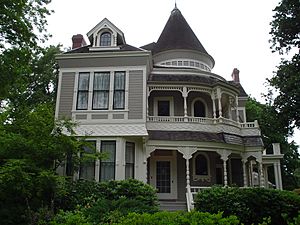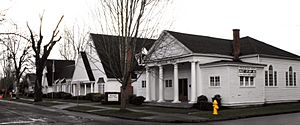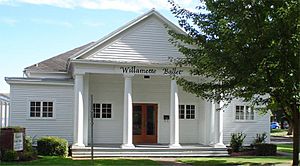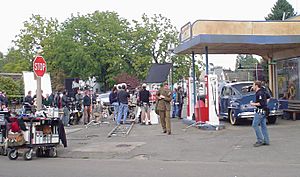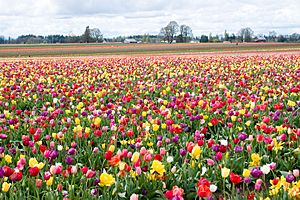Woodburn, Oregon facts for kids
Quick facts for kids
Woodburn
|
|
|---|---|
| Woodburn, Oregon | |
 |
|

Location in Oregon
|
|
| Country | United States |
| State | Oregon |
| County | Marion |
| Incorporated | 1889 |
| Area | |
| • City | 5.84 sq mi (15.12 km2) |
| • Land | 5.84 sq mi (15.12 km2) |
| • Water | 0.00 sq mi (0.00 km2) |
| Elevation | 197 ft (60 m) |
| Population
(2020)
|
|
| • City | 27,827 |
| • Estimate
(2022)
|
29,173 |
| • Density | 4,501.11/sq mi (1,737.93/km2) |
| • Metro | 400,408 |
| Time zone | UTC−8 (Pacific) |
| • Summer (DST) | UTC−7 (Pacific) |
| ZIP Code |
97071
|
| Area code(s) | 503/971 |
| FIPS code | 41-83750 |
| GNIS feature ID | 1163363 |
| Website | www.woodburn-or.gov |
Woodburn is a city in Marion County, Oregon, United States. Incorporated in 1889, the community had been platted in 1871 after the arrival of the railroad. The city is located in the northern end of the Willamette Valley between Portland and Salem. Interstate 5 connects it to major cities to the north and south. Oregon routes 211, 214, 219, and 99E also serve the city, as do Union Pacific and Willamette Valley Railway freight rail lines.
Woodburn is part of the Salem Metropolitan Statistical Area. With a population of 24,080 at the 2010 census, it is the third-most populous in that metropolitan area after Salem and Keizer.
Contents
History
Originally, the area around Woodburn was inhabited by the Kalapuya Native Americans. After the Provisional Government of Oregon set-up land claims in the Oregon Country, the United States annexed much of the Pacific Northwest and established the Oregon Territory in 1848. Congress passed the Donation Land Claim Act in 1850 and many earlier land claims became donation land claims.
Eli C. Cooley, Bradford S. Bonney, George Leisure, and Jean B. Ducharme all established donation land claims on the eastern part of the French Prairie where Woodburn would later be founded. Cooley immigrated to Oregon in 1845, and Bonney established his land claim in 1849. Ducharme's land was sold off in 1862 in a foreclosure with Mt. Angel farmer George Settlemier purchase the 214 acres (87 ha) on the cheap.
Settlemier had traveled west over the Oregon Trail in 1849 and first settled in California before moving north to Oregon in 1850. He settled in the Mt. Angel area where he was a successful nurseryman. Settlemier then moved to his new property in 1863 and established the Woodburn Nursery Company. Despite improvements to the land, including construction of his home, title in the land remained in doubt due to the purchase via a foreclosure.
During the litigation over title in the land, Settlemier borrowed money from capitalist William Reed with the land as collateral. When Reed began to build a railroad through the area, he decided to run the line through what became Woodburn in anticipation of acquiring the land himself, as he expected Settlemier to default on the mortgage. However, Settlemier did not default and eventually his case made it to the Supreme Court of the United States in Settlemier v. Sullivan, 97 U.S. 444 (1878). He gained a favorable ruling and retained the land.
Meanwhile, transportation baron Ben Holladay ran his Oregon and California Railroad through what became Woodburn in 1871, at which time Settlemier platted the first four blocks of the town.
Originally, the town and station were called Halsey, but the name was changed to Woodburn due to the existence of Halsey, Oregon, further down the valley. The name Woodburn came about after a slash burn that got out of control and burned down a nearby woodlot in the 1880s, after the railroad line had been laid through the area. A railroad official witnessed the fire and renamed the community. The city was incorporated by the Oregon Legislative Assembly on February 20, 1889.
Geography
According to the United States Census Bureau, the city has a total area of 5.37 square miles (13.91 km2), all of it land.
Demographics
| Historical population | |||
|---|---|---|---|
| Census | Pop. | %± | |
| 1890 | 405 | — | |
| 1900 | 828 | 104.4% | |
| 1910 | 1,616 | 95.2% | |
| 1920 | 1,656 | 2.5% | |
| 1930 | 1,675 | 1.1% | |
| 1940 | 1,982 | 18.3% | |
| 1950 | 2,395 | 20.8% | |
| 1960 | 3,120 | 30.3% | |
| 1970 | 7,495 | 140.2% | |
| 1980 | 11,196 | 49.4% | |
| 1990 | 13,404 | 19.7% | |
| 2000 | 20,100 | 50.0% | |
| 2010 | 24,080 | 19.8% | |
| 2020 | 27,827 | 15.6% | |
| 2022 (est.) | 29,173 | 21.2% | |
| U.S. Decennial Census 2018 Estimate |
|||
2010 census
As of the census of 2010, there were 24,080 people, 7,545 households, and 5,375 families residing in the city. The population density was 4,484.2 inhabitants per square mile (1,731.4/km2). There were 8,283 housing units at an average density of 1,542.5 per square mile (595.6/km2). The racial makeup of the city was 60.4% White, 0.5% African American, 2.8% Native American, 0.8% Asian, 0.1% Pacific Islander, 31.5% from other races, and 3.8% from two or more races. Hispanic or Latino of any race were 58.9% of the population.
There were 7,545 households, of which 35.9% had children under the age of 18 living with them, 53.8% were married couples living together, 11.6% had a female householder with no husband present, 5.9% had a male householder with no wife present, and 28.8% were non-families. 24.0% of all households were made up of individuals, and 15.6% had someone living alone who was 65 years of age or older. The average household size was 3.17 and the average family size was 3.74.
The median age in the city was 31.7 years. 30.9% of residents were under the age of 18; 9.6% were between the ages of 18 and 24; 26.2% were from 25 to 44; 17.9% were from 45 to 64; and 15.4% were 65 years of age or older. The gender makeup of the city was 50.2% male and 49.8% female.
Old Believers
Woodburn is home for a sizable community of Russian Orthodox Old Believers. This Christian traditionalist church had escaped persecution from the official Russian Orthodox Church and moved to the United States from Turkey in the 1950s. Its women wear traditional long skirts and scarfs, and its men wear beards.
Also present in the city are communities of Russian Molokans, Doukhobors and recent refugees from the former USSR: Ukrainian and Russian Pentecostals and Baptists.
Mexican immigration
In the 1950s, Mexican immigration to Oregon began to increase. Woodburn became a destination that accumulated immigrant farmworkers, and was a place where Mexican workers were caught in sweeps during a federal initiative called Operation Wetback, which returned about one million illegal immigrants to Mexico. Immigration of Mexicans to Woodburn continued to increase through the 1980s, when Latinos made up about 2.5 percent of Oregon's population. By the early 21st century, 59% of the population of Woodburn was Latino, with a mix of first-generation immigrants and long-term residents.
Woodburn Estates
Woodburn is also home to the largest 55+ retirement community in Oregon with 1510 single family homes, a mobile home park, a private, eighteen hole golf course surrounding a clubhouse with auditorium, swimming pool, fitness center, restaurant, billiards room, crafts room, RV storage, and a variety of social events, clubs and activities.
Arts and culture
Willamette Ballet Academy was founded in 1982.
Scenes from 2007 Hallmark Hall of Fame production The Valley of Light, starring Chris Klein, were filmed in Woodburn.
Museums and other points of interest
Listed in 1974 on the National Register of Historic Places, the Jesse H. Settlemier House is a museum located on Settlemier Avenue.
The World's Berry Center Museum was founded in the early 1980s. The World's Berry Center Museum occasionally produces plays by Miracle Theatre.
La Fiesta Mexicana is the most important Hispanic event in the area. Each fiesta should include a queen; Francisca Gonzalez was the first selected to receive this honor in the first fiesta in 1964. It was a one-day event that was held in downtown Woodburn. Forty-five years later, the event grew more popular and now it currently lasts close to a week. One of the main reasons this event happened was that the ranchers and merchants recognized the importance of the new bicultural relationship with the increased Hispanic population in the area.
Economy
In August 1999, Woodburn Premium Outlets, known as the Woodburn Company Stores until June 2013, opened in Woodburn. This is an outlet mall with many name-brand clothing companies represented, including Adidas, Nike, Gap, and Banana Republic.
MacLaren Youth Correctional Facility is on Oregon Route 99E on the outskirts of Woodburn, in which young delinquent and criminal males are incarcerated.
Sports
The Woodburn Dragstrip is a 1/4-mile National Hot Rod Association (NHRA) dragstrip that hosts an annual event on the NHRA Lucas Oil Series. It is located about 2 miles (3 km) west of Woodburn on Oregon Highway 219.
The Oregon Golf Association (OGA) Golf Course in Woodburn is a public course, rated by Golf Digest in 1996 as one of the top 10 affordable courses in the United States. It routinely hosts many large amateur and high school events in the state.
The Woodburn Golf Club is a 9-hole public course 2 miles west of Woodburn. Established in 1925, play is on a first come basis with sand greens.
Education
Woodburn is served by the Woodburn School District, which includes four elementary schools and two middle schools. Woodburn High School includes the following small schools: the Wellness, Business and Sports School, the Woodburn Academy of Art, Science and Technology, the Academy of International Studies at Woodburn, and the Woodburn Arts and Communications Academy. Woodburn Success High School is the district's alternative high school, serving grades 7–12.
Chemeketa Community College has a satellite campus in Woodburn.
Pacific University opened a College of Education satellite campus in 2012.
Infrastructure
Transportation
The Transit Division of the Woodburn Community Services Department runs the Woodburn Transit System (WTS), which uses small buses during non-holiday weekdays within the city's limits, and the Dial-a-Ride program, which operates paratransit vans for reservation by the elderly and disabled during weekdays within the local area and, for medical appointments, anywhere between Portland and Salem.
Other public bus systems making stops in Woodburn include CARTS (Chemeketa Area Regional Transportation System), administered by Oregon Housing and Associated Services, Inc. (OHAS) in Salem, and CAT (Canby Area Transit), run by the city of Canby. Both also only operate during non-holiday weekdays.
Greyhound buses also stop in the city. Amtrak's Coast Starlight and Cascades trains pass through but do not stop. The Amtrak affiliated Cascades POINT bus service stops at the Woodburn Park & Ride at the Woodburn I-5 exit.
Notable people
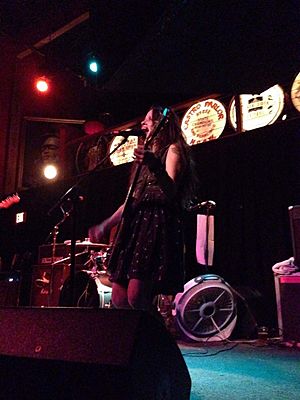
Stacy Allison (born 1958), a 1976 graduate of Woodburn High School and a 1984 Oregon State University alum, was the first American woman to reach the summit of Mount Everest, during her second attempt on September 29, 1988. That same year, when Mayor Nancy Kirksey declared November 17 "Stacy Allison Day," she visited and spoke at several Woodburn venues and attended ceremonies when a street in the city, Stacy Allison Way, was dedicated to her.
Kat Bjelland, of the punk band Babes in Toyland, grew up in Woodburn. Her first performance was at the now-closed Flight 99 tavern.
Model and actress Kate Nauta grew up in Woodburn and lived there until 2000.
Woodburn-born baseball player Dick Whitman was an outfielder for the Brooklyn Dodgers and Philadelphia Phillies; the teams played in the 1949 and 1950 World Series, respectively.
See also
 In Spanish: Woodburn (Oregón) para niños
In Spanish: Woodburn (Oregón) para niños



